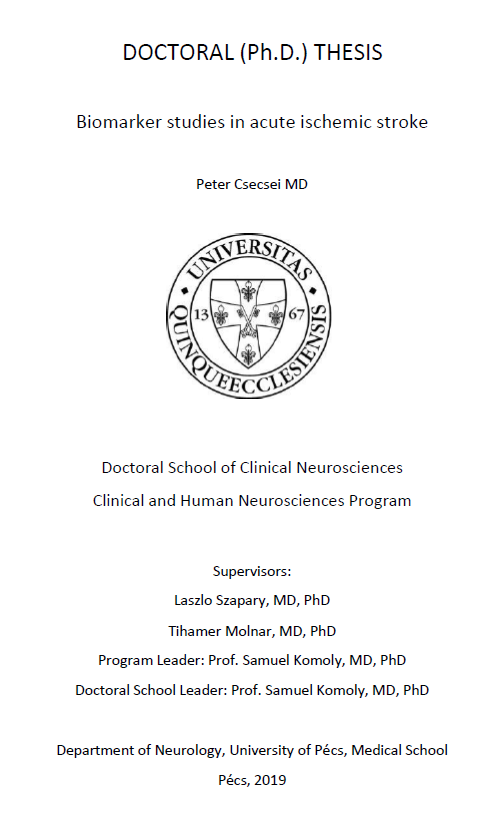Biomarker Studies in Acute Ischemic Stroke
Abstract
Stroke is defined by WHO as the clinical syndrome of rapid onset of focal (or global, as in
subarachnoid haemorrhage) cerebral deficits lasting more than 24 hours or leading to death,
with no apparent cause other than a vascular one. Of all strokes, 87% are ischemic, 10% are
intracerebral hemorrhage, and 3% are subarachnoid hemorrhage strokes. The TOAST (Trial
of Org 10172 in Acute Stroke Treatment) classification is based on clinical symptoms as well
as results of further investigations. Accordingly, a stroke is classified as either thrombosis or
embolism due to atherosclerosis of a large artery, an embolism originating from the heart
(cardiogenic stroke), a complete blockage of a small blood vessel (lacunar) or other
determined/undetermined cause. Cardioembolic stroke accounts for 14-30% of ischemic
strokes and atrial fibrillation (AF) is responsible for about 50% of cardiogenic strokes. Cardiac
embolism causes more severe strokes than any other ischemic stroke subtypes resulting in
more impairments (modified Rankin scale), more dependency (Barthel Index), and higher
mortality. Several blood biomarkers have been emerged in the last decade in association of
the evolution, diagnosis and prognosis of ischemic stroke. Some of them are organ specific
(e.g. astrocyte damage marker - S100B), others reflect the preceding atherosclerosis such as
hsCRP or indicators of endothelial dysfunction or thrombo-inflammation.
S100B in the peripheral blood is a sensitive marker of both blood–brain barrier dysfunction
and ischemic brain damage and predictor of stroke outcome. Increased high-sensitivity Creactive
protein (hsCRP) in the subacute stage is an independent predictor of death.
Thrombo-inflammatory molecules (tissue plasminogen activator [tPA], soluble CD40 ligand
[sCD40L], P-selectin, interleukin-6, interleukin-8, monocyte chemoattractant protein-1 [MCP-
1]) connect the prothrombotic state, endothelial dysfunction, and systemic/ local
inflammation in acute vascular events such as myocardial infarction or ischemic stroke.
Besides other factors, MCP-1 plays a crucial role in atherogenesis. On the other hand, shear
stress-induced overexpression of MCP-1 contributes significantly to the development of
protective collaterals in the heart, but little is known about its role in the cerebral
vasculature. Cardiac troponins (cTn) are sensitive and specific biomarkers used in the
diagnosis of myocardial infarction (MI). Primarily, cTn is released into the bloodstream when
cardiac myocytes are damaged by acute ischemia. Beside MI, there are several clinical
conditions, such as stroke accompanied by troponin elevation. However, the exact
mechanism of such increased concentration of cTn in stroke patients without apparent
myocardial damage is not fully explored.
Nitric oxide (NO) plays a role in maintaining vascular integrity. NO is synthetized by the
oxidation of L-arginine, which can be inhibited by asymmetric dimethylarginine (ADMA).
Symmetric dimethylarginine (SDMA) competes with arginine uptake and antagonizes the
effects of L-arginine. The plasma concentration of L-arginine and its dimethylated derivatives
ADMA and SDMA were associated with long- term mortality in patients followed up to 7
years after an acute ischemic stroke. In addition, SDMA level in the plasma was strongly
associated with adverse clinical outcome during the first 30 days following ischemic stroke.
Furthermore, a subacute elevation of both ADMA and SDMA proved to be predictors of poor
functional outcome at 90 days.
Several studies have demonstrated that a beat-to beat variation in the blood flow, which
occurs in patients with AF, adversely affects the endothelial function by modulating the production of vasoactive substances produced by endothelial cells. Myocardial blood flow
alterations caused by decreased production of nitric oxide (NO) lead to endothelial
dysfunction. Emerging clinical and experimental evidences indicate that ADMA and SDMA
are involved in the pathophysiology of endothelial dysfunction, atherosclerosis, oxidative
stress, inflammation and apoptosis. All of these pathological processes play pivotal role in
the development of AF.

